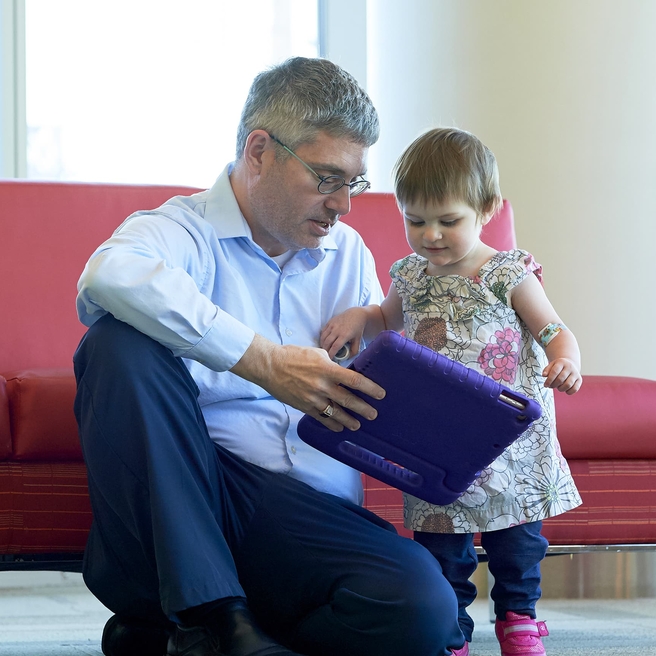What is a peanut allergy?
Peanut allergy is one of the most common IgE-mediated food allergies among children. Nearly 2.5 percent of all children in the United States may have an allergy to peanuts.
A child with a peanut allergy will show symptoms within minutes to hours of consuming food containing peanuts. Symptoms may include difficulty breathing, nausea, hives
Causes of peanut allergies
A peanut allergy occurs when the body misidentifies peanut proteins as something harmful. The body defends itself by releasing histamine, a chemical that causes symptoms such as coughing, wheezing and hives.
Signs and symptoms of a peanut allergy
If your child is allergic to peanut, it may cause symptoms in multiple areas of the body, including:
- Skin: hives (red, blotchy skin that can itch) and may include mild to severe swelling
- Lungs: difficulty breathing, shortness of breath, coughing or wheezing
- Eyes: itching, tearing or redness
- Throat: tightness, trouble breathing or inhaling
- Stomach: repeated vomiting, nausea, abdominal pain and cramping or diarrhea
- Nose: congestion, copious clear discharge, sneezing or itching
- Neurologic: change in behavior or mood, dizziness
- Drop in Blood Pressure: This is the most dangerous symptom of a severe allergic reaction
If your child experiences any of these symptoms after ingesting a peanut or peanut protein, call your pediatrician and arrange to have your child tested by a pediatric allergist.
If a child has any two systems involved from the above list, this means they may be experiencing anaphylaxis.
If your child has symptoms of anaphylaxis, call 911 immediately.
Testing and diagnosis of peanut allergy
If you suspect your child is allergic to peanuts, clinicians at Children’s Hospital of Philadelphia will take a detailed medical history of your child, including information on prior food reactions. Based on your child’s history and findings, our clinicians may order one or more of the following tests:
Skin test
In allergy skin testing, a very small amount of the food allergen is introduced to the skin — typically on your child’s forearm — through a gentle pinprick. The appearance of a hive-like bump may indicate a peanut allergy.
Blood test
In allergen-specific IgE blood tests, a small amount of your child's blood is drawn and tested for antibodies the child may have produced in response to exposure to an allergen.
Food challenge
A food challenge test involves giving your child a small increasing amounts of peanut protein in a controlled, highly supervised clinical setting to monitor for any reactions.
Treatments for peanut allergy
Once your child is confirmed to have a peanut allergy, the first step in treatment is avoiding peanuts and food containing peanuts or peanut protein.
Your child’s doctor can give you detailed information on how to read food labels to help identify and avoid peanut protein.
No matter how careful you are, there may be times when your child is accidentally exposed to peanuts (or ingests them) and has a reaction. When that happens, you can treat the symptoms with antihistamines or epinephrine.
If more than one body system is involved in the allergic reaction — for example the skin and lungs — it is recommended to use epinephrine. Epinephrine comes in a variety of forms, including auto-injectors such as Epi-Pen, Auvi-Q and other generic forms.
If your child’s reaction is mild and only involves a few hives, an over-the-counter or prescription strength antihistamine can ease their symptoms. Your child’s doctor can help you decide which option is best for your child, depending on the circumstance and their reaction.
Children with peanut allergies should carry epinephrine with them, or it should be readily available at places where they routinely spend time, such as school, daycare and home.
Your Child's Allergy Appointment
Learn what to expect during your child's visit with Allergy and Asthma, including what to bring and what to do in the days leading up to the appointment.
When to call 911
If your child has a severe reaction or signs of anaphylaxis, administer epinephrine and then call 911 right away. In some circumstances, children may need more than one dose of epinephrine, so it is important to have medical assistance in these situations if needed.
Oral immunotherapy
Oral immunotherapy (OIT), may help desensitize your child to peanut. Your child will ingest small quantities of peanut protein in a controlled setting to monitor for reactions, then continue that amount of peanut protein every day at home. The amount of peanut protein will be gradually increased under close medical supervision at the hospital. Your healthcare provider can help you decide if oral immunotherapy may be appropriate for your child. If so, you'll receive a referral to CHOP’s Oral Immunotherapy Program.
Follow-up care for peanut allergies
Most of the ongoing treatment for food allergies can be done at home. Once your child has been diagnosed with a peanut allergy, you and your family will be given more information on how to avoid exposure to peanuts and treat any reactions you child may experience.
You may also want to share information about your child's allergy with your extended family, close friends and your child's school so they can help reduce the chance of accidental exposure outside your home.
Outlook for children with peanut allergy
Unlike many other common food allergies, peanut allergies tend to persist into adulthood. Only about 20 percent of children with peanut allergies will outgrow them.
If repeat allergy testing suggests your child has outgrown their peanut allergy, your child should undergo a supervised test, such as a food challenge, to determine whether it’s safe to incorporate peanuts into their normal diet.
Resources to help
Food Allergy Center Resources
Caring for a child with a food allergy can be challenging. To help you find answers and feel confident with the care you’re providing your child, we’ve created the following list of health resources.


